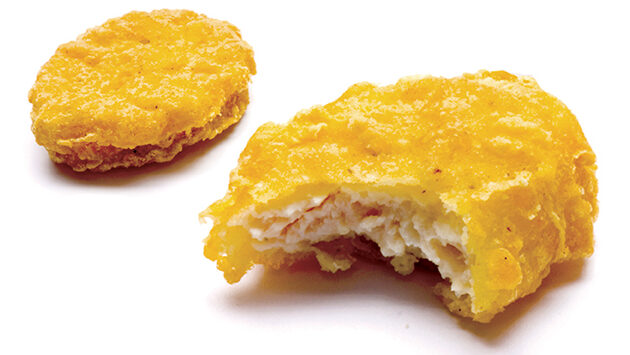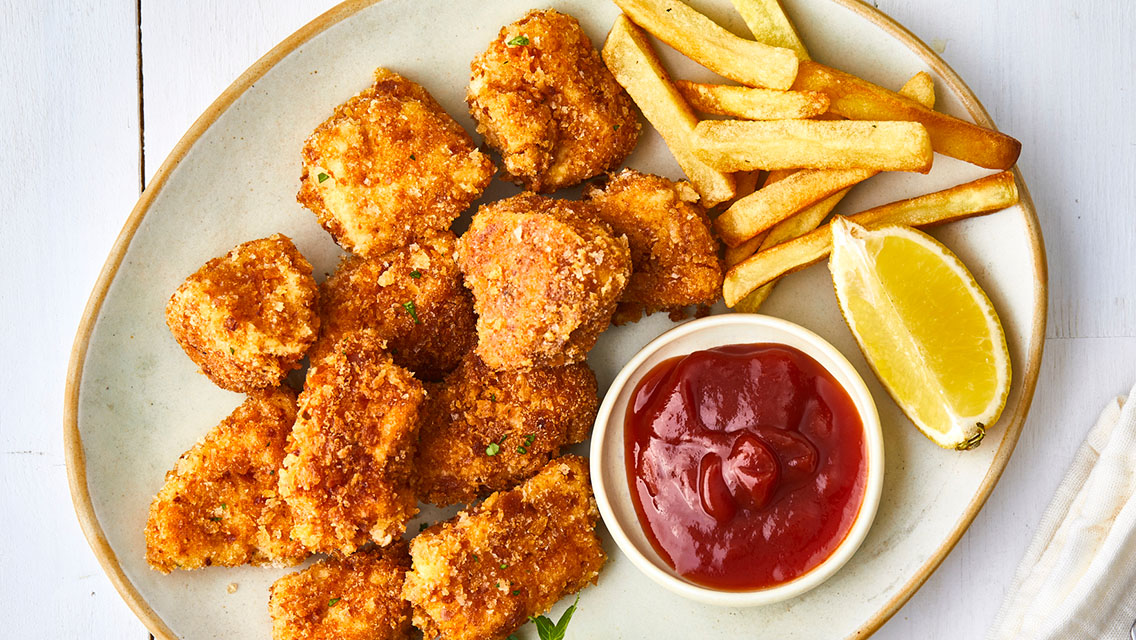Show me a chicken nugget, and I will show you the world. The world, that is, of highly palatable foods engineered by the food industry to go down easily — and stimulate cravings.
Commercial foods like chicken nuggets, French fries, chips, crackers, cookies and pastries are designed to be virtually irresistible. Food manufacturers leverage science and technology to enhance their products — manipulating food in ways that not only play on our innate fondness for sugar, salt and fat, but also dramatically boost their overall taste, texture, aroma and appearance.
Here are some of the factors that make chicken nuggets so easy to eat (and eat and eat):
BITE-SIZE: Before breading, the gelatinous meat product is squeezed into a casing and cooked. After it cools, the casing is sliced into uniform nugget-sized discs, making them that much easier to pop into your mouth (no silverware required — and hey, those nuggets are so small, it’s like you’re hardly eating anything, right?).
“PRECHEWED” MEAT: Assorted pieces of chicken meat are finely chopped to free myofibrillar proteins that act as “glue” to bind the bits of meat together. Texture-enhancing binders (such as breading or powdered egg white) are added to help create a “gelling” effect that gives the nuggets shape. Flavors, natural and artificial, are mixed in. So are ingredients that hold in moisture, such as sodium phosphate, soy protein concentrate and autolyzed yeast extract. The net effect? A boneless, prechewed quality that produces a smooth and even bolus in your mouth — and that invites overeating.
WHITE-ISH MEAT: It could be white meat — or it could be dark meat (about a third of the cost of white meat) that has been whitened with the use of whey protein concentrate and whey protein isolate. Although dark meat is often more flavorful, white meat apparently looks more uniform and more appealing to American eyes. As one industry document puts it, “American consumers have expressed a strong preference for poultry white meat over dark meat due to color. Turning dark meat into white could open new markets and revenue sources.”
CRUNCH FACTOR: The breading on a chicken nugget is mostly flour (but can also contain gums, starches, sugars and chemically derived flavors). It adds inexpensive heft to the nugget (up to 30 percent of its weight) and provides a material for the nugget’s crispy outside layer — a key factor in the sensory experience. The breading also provides an appealing, uniform color (some manufacturers add a caramel coloring agent to the nugget to enhance the golden, fried look) and toasty aroma. Finally, the breading provides a moisture barrier to prevent water loss, creating a moist interior that contributes to a satisfying mouthfeel.
FRIED TO A CRISP: The chicken nugget is dunked in a vat of hot, liquid fat (most often, a cheap vegetable oil such as soybean, sunflower or safflower oil — it depends on market price and availability), which causes the protein to denaturalize and the starch in the breading to become more gel-like. A crust forms on the nugget’s outer layer. During deep-frying, much of the nugget’s original water content is replaced with oil.
SWEET SAUCE: Most of the sauces served with chicken nuggets (barbecue, sweet and sour, etc.) have an array of added sugars in them. Others, like ranch and blue-cheese dressings, combine creamy dairy ingredients with added sugars. This helps to create the fat-sugar-salt trio that renders so many processed foods irresistible. Although the ingredients of one popular restaurant chain’s ginger-citrus sauce sound relatively ordinary (sugar, hoisin sauce, vinegar, soy sauce, garlic, chili paste, modified food starch and orange juice concentrate), sugar and salt dominate. The dipping action produces new sensory elements — mixing cool with hot, crispy with creamy, savory with sweet, mellow with spicy, and so on.
This originally appeared in “Scary Food Science” in the October 2010 issue of Experience Life.




This Post Has 0 Comments